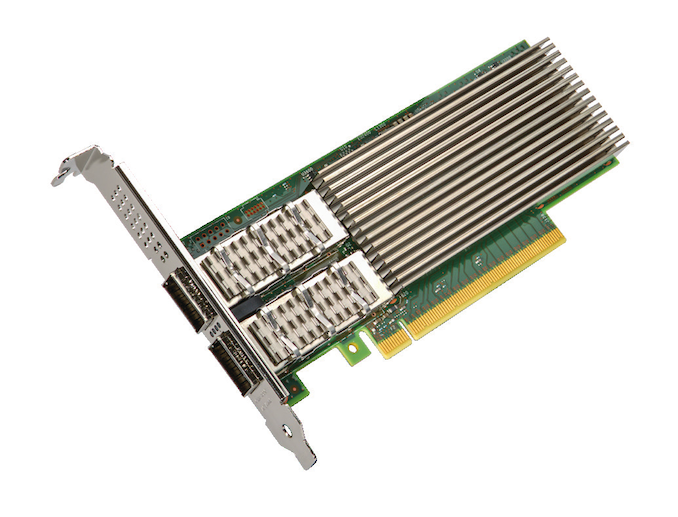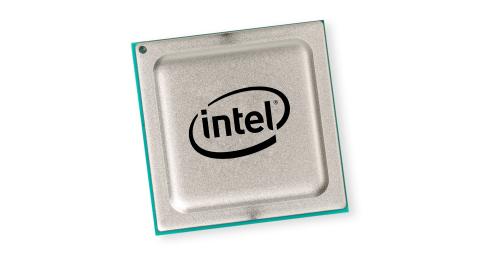Intel Ethernet 800 Series To Support NVMe over TCP, PCIe 4.0
by Billy Tallis on September 24, 2019 3:30 PM EST- Posted in
- Networking
- Intel
- Ethernet
- PCIe 4.0
- NVMeoF
- 100G
- 100G Ethernet
- Columbiaville

Today at the SNIA Storage Developer Conference, Intel is sharing more information about their 100Gb Ethernet chips, first announced in April and due to hit the market next month. The upcoming 800 Series Ethernet controllers and adapters will be Intel's first 100Gb Ethernet solutions, and also feature expanded capabilities for hardware accelerated packet processing. Intel is now announcing that they have implemented support for the TCP transport of NVMe over Fabrics using the Application Device Queues (ADQ) technology that the 800 Series is introducing.
NVMe over Fabrics has become the SAN protocol of choice for new systems, allowing for remote access to storage with just a few microseconds of extra latency compared to local NVMe SSD access. NVMeoF was initially defined to support two transport protocols: Fibre Channel and RDMA, which can be provided by Infiniband, iWARP and RoCE capable NICs. Intel already provides iWARP support on their X722 NICs, and RoCEv2 support was previously announced for the 800 Series. However, in the past year much of the interest in NVMeoF has shifted to the new NVMe over TCP transport specification, which makes NVMeoF usable over any IP network without requiring high-end RDMA-capable NICs or other niche network hardware. The NVMe over TCP spec was finalized in November 2018 and opened the doors to much wider use of NVMe over Fabrics.
Software-based NVMe over TCP implementations can use any network hardware, but for the high-performance applications that were originally the focus of NVMe over Fabrics, hardware acceleration is still required. Intel's ADQ functionality can be used to provide some acceleration of NVMe over TCP, and they are contributing code to support this in the Linux kernel. This makes the 800 Series Ethernet adapters capable of using NVMe over TCP with latency almost as low as RDMA-based NVMe over Fabrics. Intel has also announced that Lightbit Labs, one of the major commercial proponents of NVMe over TCP, will be adding ADQ support to their disaggregated storage solutions.
Unrelated to NVMe over Fabrics, Intel has also announced that Aerospike 4.7 will be the first commercial database to make use of ADQ acceleration, and Aerospike will be publishing their own performance measurements showing improvements to throughput and QoS.
The Intel Ethernet Controller E810 and four 800 Series Ethernet adapters will be available from numerous distributors and OEMs over the next several weeks. The product brief for the E810 controller has been posted, and indicates that it supports up to a PCIe 4.0 x16 host interface—to be expected from a 100Gb NIC, but not something Intel PR is keen to highlight while their CPUs are still on PCIe 3.0.
Related Reading
- Intel Columbiaville: 800 Series Ethernet at 100G, with ADQ and DDP
- Intel’s Enterprise Extravaganza 2019: Launching Cascade Lake, Optane DCPMM, Agilex FPGAs, 100G Ethernet, and Xeon D-1600
- NVIDIA To Acquire Datacenter Networking Firm Mellanox for $6.9 Billion
- Western Digital to Exit Storage Systems: Sells Off IntelliFlash Division
- Marvell at FMS 2019: NVMe Over Fabrics Controllers, AI On SSD











48 Comments
View All Comments
name99 - Wednesday, September 25, 2019 - link
Price is not the whole point.Yes, they're "affordable". But they're too large, and too loud, at least in part because they offer too much. And THAT is what people like me are complaining about.
What we want is something like
https://www.amazon.com/gp/product/B000N99BBC/
just with every port replaced with 2.5G
And the point is not the cost; I'd be happy to pay 10x the cost of the 1G version.
But I want that size, that power budget, that simplicity.
jabber - Wednesday, September 25, 2019 - link
Yeah it might be fine if you are living in your parents basement but wives and such like take a dim view to enterprise kit in the living room. Rightly so.bcronce - Wednesday, September 25, 2019 - link
Won't sound like a 747 for long. Those high pressure fans will clog. I only go fan-less. No dust bunnies, just a fine coat of dust. Anything with a fan gets a winter coat of fur in no time.Samus - Wednesday, September 25, 2019 - link
True, most of the 10Gb switches are pretty quiet unless they are also PoE+ and under heavy load. Any modern switch had load-sensitive fans anyway.Kevin G - Wednesday, September 25, 2019 - link
Businesses tend to want warranties and support with their devices and thus the eBay route is generally not an option. Those businesses are generally the ones who are flooding eBay with equipment to sell: as soon as they're out of warranty/support contract, the hardware gets moved off to a recycler who often posts it on eBay.As for 2.5 Gbit, that data rate can be had effectively 'for free' as it is changing the symbol space on the existing 1 Gbit encoding (only 100 of 256 are used). If 1 Gbit works on existing cabling, 2.5 Gbit will as well. Re-running cable is not fun, especially if moving from vanilla Cat5e to something more robust like Cat6A STP or Cat7.
Fiber costs have come down considerably but the cabling remain more fragile than copper and outside of the data center, power-over-cable is popular for many devices.
beginner99 - Wednesday, September 25, 2019 - link
Because 10gb requires rewiring, either to fiber or cat6 cables. Plus most consumers don't have fiber internet and hence asynchronous connection speed with upload usually being mostly unusable for any large file transfers.beginner99 - Wednesday, September 25, 2019 - link
Because the average consumer (read most of them) doesn't use Ethernet at all. The market is too small. And myself that has a lot of media files, I really don't need it. it's not like I'm copying the files around between machines. The get consumed and 1gb is more than enough for that. not to mention that most hdds can't even continuously saturated 1gb.beginner99 - Wednesday, September 25, 2019 - link
Oh and i forogt with many providers you get an all-in one device which is modem, router, switch and wifi AP in one. often with config locked down and obviously a 1gb switch. To setup a 2.5/5 GB network you will net to change that device into a pure modem (if possible at all) and buy your own 2.5gb wifi router. here 95% of people would already fail...and then you need 2.5gb on all your devices or at least your PC and your NAS. Show me a consumer NAS with 2.5gb LAN.Dug - Wednesday, September 25, 2019 - link
Synology DS1620xs, and I believe other 2020 models will be coming with 2.5Gb as well. Along with an Asus GT-AX11000 router, or Netgear Nighthawk has 2.5Gb.This would work well if using wifi6. Modules are cheap and easy to buy.
Personally I would just jump to 10Gb as that can be put into Synology and many Qnap's already have 10Gb built in.
The problem with 10Gb though is that most adapters will only work at 10 or 1, and not step in-between, so planning is essential.
name99 - Wednesday, September 25, 2019 - link
The best you can do today, as far as I can tell is- do your own cable modem
- get a Nighthawk AX12 which will give you WiFi6, 2 USB3 ports (not C...), and on the LAN side
+ one 5/2.5G port and
+ 4 1G ports
+ of which two can be aggregated to give you a 2x1G
Not a great set of options there, but still MAYBE (depending on your house's circumstances) can be converted into something useful.
The real shame is that they didn't work just a little bit harder to give two multi-gig ports rather than one, which would have been so much more useful...